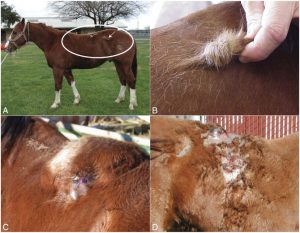

We’ve refined our HERDA test.
HERDA is an autosomal recessive disorder, meaning that it is not sex-linked, and that HERDA carriers with one copy of the gene are not affected. HERDA is part of the Quarter Horse and Paint Horse 5-panel, and is most commonly found in cutting lines.
Horses with two copies of the HERDA gene have extremely fragile skin, particularly along their back. Their skin can rip or tear easily, and the large wounds that result from this tearing are painful and like most wounds on horses carry a substantial risk of infection.
We refined our HERDA test because it was almost TOO sensitive. Sometimes HERDA carriers showed such a strong positive that we would have to dilute the sample and run it again to confirm that there was an ’n’ allele present too. This refinement of the HERDA test will help make sure that all HERDA results get sent out quickly.
Click here to order a HERDA test for your horse
Photo sources from Homozygosity mapping approach identifies a missense mutation in equine cyclophilin B (PPIB) associated with HERDA in the American Quarter Horse by Authors Robert C. Tryona, Stephen D. White, Danika L.Bannascha